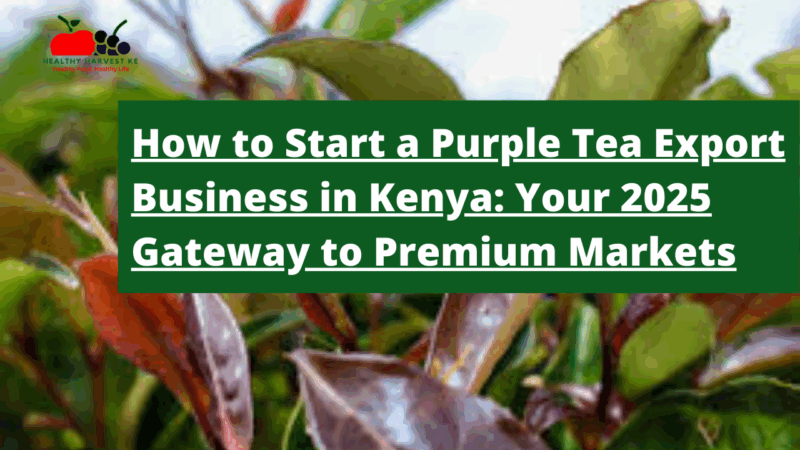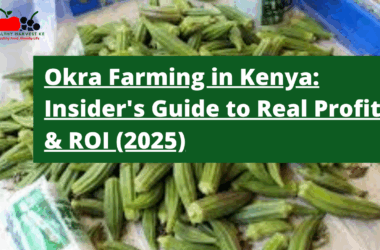You’ve probably seen the usual tea fields across Kenya’s highlands. But there’s a new player changing the game – purple tea. Not just another crop, it’s a goldmine waiting for smart entrepreneurs who know where to look.
Ready for the numbers that’ll make you sit up? While regular black tea goes for about $2.85 per kilo at auction, purple tea commands up to $30 per kilo in international markets. That’s not a typo – we’re talking about a 10x price premium.
If you’re an entrepreneur looking to break into an export business with serious growth potential, purple tea might be your perfect play. Let’s break down how you can get started.
What Makes Kenyan Purple Tea a Premium Export Product
The secret to purple tea’s market appeal? It’s not just another pretty leaf.
Purple tea contains higher levels of anthocyanins – the same antioxidants found in blueberries and other superfoods. These compounds give the tea its distinctive color and pack it with health benefits that health-conscious consumers in North America, Europe, and China can’t get enough of.
Compared to traditional black and green varieties, purple tea offers:
- Higher antioxidant content
- Lower caffeine levels
- Unique flavor profile
- Distinctive purple color that stands out on shelves
These qualities have caught the attention of major international buyers. Companies like International Tea Importers in California have positioned themselves as primary importers, with their COO Bhavin Shah calling purple tea “the first true innovation in the Camellia Sinensis plant since its inception thousands of years ago.”
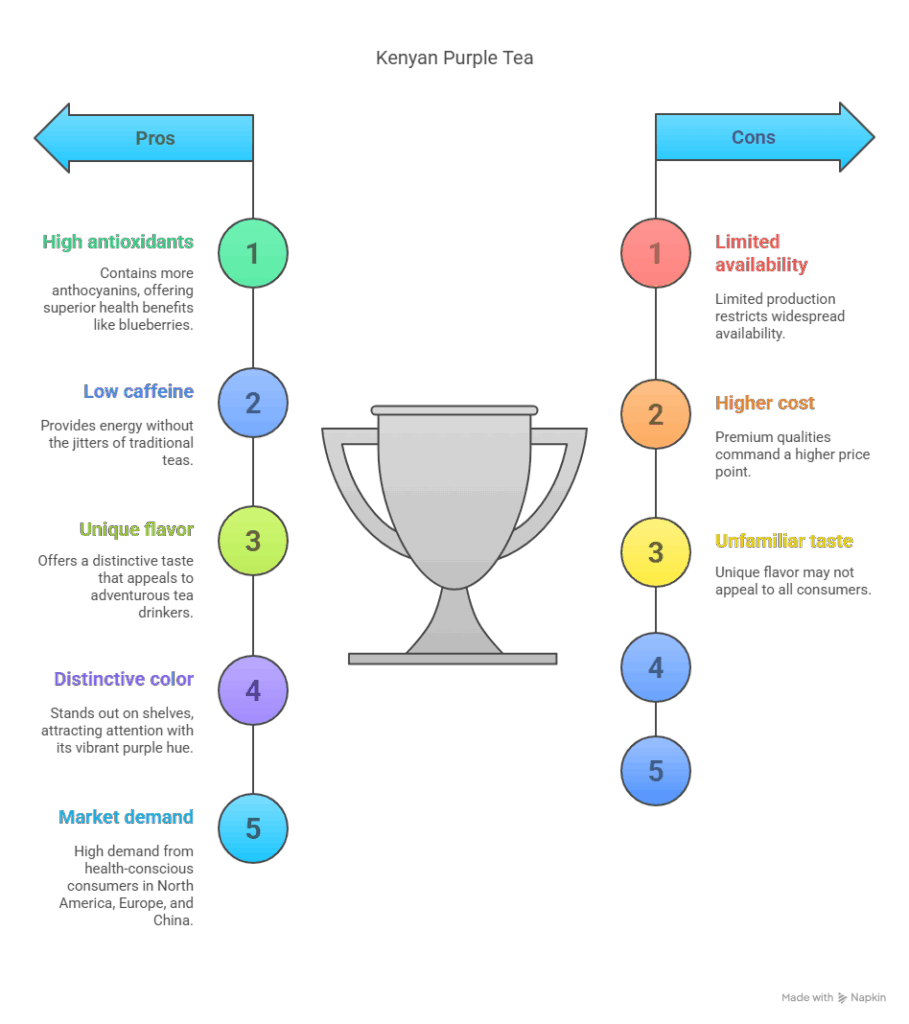
The Financial Case for Purple Tea Export
Let’s talk cash – because that’s what matters when you’re launching a business.
The math behind purple tea is straightforward and compelling. While Kenya’s traditional black tea sells for around $2.85 per kilo at the Mombasa auction, purple tea wholesale blends fetch between $19 and $30 per kilo in international markets.
Here’s how that translates to your bottom line:
| Tea Type | Average Export Price (per kg) | Potential Premium |
|---|---|---|
| Black Tea | $2.85 | Baseline |
| Purple Tea | $19-30 | 566%-952% |
This price differential creates an opportunity that’s rare in agricultural exports – a chance to earn premium prices with a crop that grows well in Kenya’s existing tea regions.
What’s driving this value? Consumer demand for unique, health-focused products with compelling stories behind them. Purple tea ticks all these boxes, and smart entrepreneurs who can communicate this value stand to capture significant margins.
Getting Started: Land and Cultivation
Your first step into the purple tea business starts with the right land and cultivation practices.
Land Requirements
Purple tea thrives in Kenya’s central highlands, particularly in areas like Murang’a County with:
- Elevations between 1,500-2,500 meters
- Rich, well-draining volcanic soils
- Cool temperatures and moderate rainfall
- Protection from extreme weather
You don’t need massive acreage to start. Take Darius Kizito’s Umbui purple tea farm – at 4.4 hectares, it’s created a profitable operation that employs dozens of workers and supplies processing factories with premium tea.
Sourcing Purple Tea Varieties
The Tea Research Foundation of Kenya (TRFK) spent 25 years developing specialized purple tea varieties like TRFK 306/1 that are:
- Drought-resistant
- Disease-resistant
- Frost-resistant
- Higher-yielding than traditional tea (1.5-3kg per bush annually)
Contact the TRFK directly to source these specialized varietals. Their expertise will help you select the right plants for your specific location and conditions.
Cultivation Best Practices
Purple tea requires similar but slightly different cultivation practices compared to black tea:
- Spacing: Plant bushes 4-5 feet apart to allow for proper growth
- Soil preparation: Ensure proper drainage and organic matter content
- Irrigation: While drought-resistant, consistent moisture improves yield and quality
- Pruning: Regular pruning promotes fresh shoots and maintains plant health
- Harvesting: Focus on the youngest leaves for premium quality
The good news? If you or your team have experience with traditional tea farming, you already have most of the skills needed for purple tea cultivation.
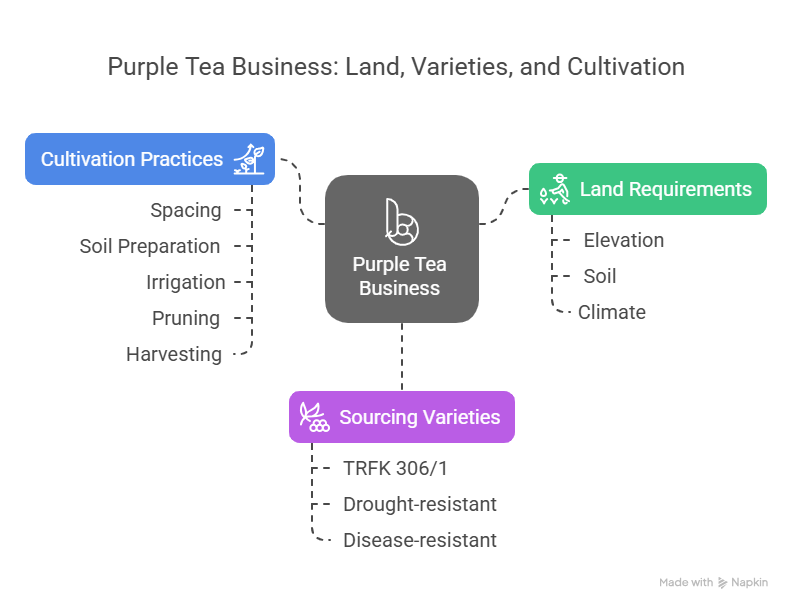
Processing: Where the Value Gets Added
Processing is where you can really boost your profit margins. While exporting raw tea leaves has potential, adding value through processing is where the real money lies.
Processing Requirements
To process purple tea for export, you’ll need:
- Sorting facilities for separating leaves by quality
- Drying equipment or greenhouse space for initial moisture reduction
- Specialized processing equipment (similar to what’s used at Gatanga Industries Tea Factory)
- Quality control systems that meet international standards
- Packaging capabilities that preserve freshness and showcase product quality
Consider visiting established processors like Gatanga Industries to learn about their operations and equipment needs. They began operations in 2017 specifically to meet growing purple tea demand.
Value Addition Strategies
The Kenyan government has committed approximately 1 billion Kenyan shillings (about 7 million euros) to encourage value addition in the tea sector. This support can help you implement strategies like:
- Creating signature blends that highlight purple tea’s unique properties
- Developing branded, ready-to-drink products
- Obtaining specialty certifications (organic, fair trade, etc.)
- Creating premium packaging that tells your product’s story
- Developing direct consumer channels in target markets
Companies like LEAFBERRI have built successful business models by sourcing directly from small-scale farmers and marketing specialty Kenyan teas, including purple tea, to international consumers.
Market Entry: Finding Your Buyers
With your production and processing in place, it’s time to connect with buyers who’ll pay premium prices for your purple tea.
Primary Target Markets
Based on current export patterns, focus your efforts on:
- North America – The largest importer of Kenyan purple tea, with approximately 10 metric tons imported in 2017
- Europe – Growing demand for specialty and health-focused teas
- China – Despite being a major tea producer, China imports purple tea for its unique properties
Within these markets, target:
- Specialty tea importers and distributors
- Health food chains and specialty grocers
- Direct-to-consumer e-commerce platforms
- Premium tea shops and cafes
Export Documentation and Compliance
To export from Kenya, you’ll need:
- Export license from the Kenya Export Promotion and Branding Agency
- Certificate of origin
- Phytosanitary certificate
- Commercial invoice and packing list
- Bill of lading or airway bill
- Any special certifications (organic, fair trade, etc.)
Work with an experienced freight forwarder who specializes in agricultural exports to navigate these requirements.
Market Entry Strategies
Consider these approaches to break into international markets:
- Partnership with existing exporters: Collaborate with established tea exporters to gain access to their distribution networks
- Direct relationships with specialty importers: Connect directly with companies like International Tea Importers in California
- E-commerce platforms: Develop your own direct-to-consumer channels for higher margins
- Trade shows and exhibitions: Showcase your products at international tea and specialty food exhibitions
Each strategy has different capital requirements and risk profiles. Many successful exporters start with partnerships and gradually develop direct relationships as they build their brand.
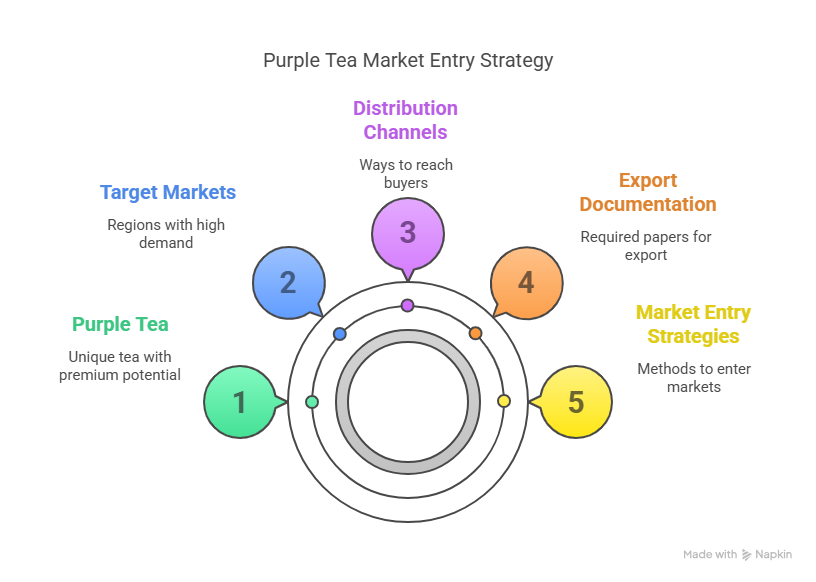
Funding Your Purple Tea Export Business
Starting a purple tea export business requires capital – here’s how to find it.
Startup Costs
Be prepared for these primary expenses:
- Land acquisition or leasing (if you don’t already have suitable land)
- Seedling purchase and planting (approximately KES 10-15 per seedling)
- Basic farming equipment and infrastructure
- Processing equipment (your largest capital expenditure if you’re vertically integrating)
- Initial marketing and business development
- Export certification and compliance costs
Funding Sources
Consider these funding options:
- Agricultural finance programs: Many Kenyan banks offer specialized loans for agricultural businesses
- Government initiatives: The tea sector development funds mentioned earlier may provide grants or low-interest loans
- International development agencies: Organizations supporting agricultural exports in East Africa
- Private investors: Angel investors or venture capital for businesses with strong growth potential
- Cooperative models: Pooling resources with other small-scale farmers to share costs
The Kenya Tea Development Agency (KTDA) may also provide support for farmers transitioning to purple tea production.
Challenges and How to Overcome Them
Every business faces hurdles – here’s what to watch for with purple tea exports.
Market Education
Challenge: Many international consumers are still unfamiliar with purple tea and its benefits.
Solution: Develop educational marketing materials that clearly communicate purple tea’s unique properties and health benefits. Share the compelling story of this innovative Kenyan crop.
Quality Consistency
Challenge: Maintaining consistent quality across harvests and processing batches.
Solution: Implement strict quality control systems and consider investing in specialized training from Chinese or Japanese tea experts who have experience with similar tea varieties.
Scale vs. Premium Positioning
Challenge: Balancing growth with maintaining the premium qualities that command high prices.
Solution: Focus on quality over quantity, especially in early growth phases. Consider a tiered product strategy with different quality grades for different market segments.
Logistics and Transportation
Challenge: Ensuring tea arrives at international destinations fresh and undamaged.
Solution: Partner with specialized agricultural product exporters who understand the unique requirements of tea transportation and have established cold chains when necessary.
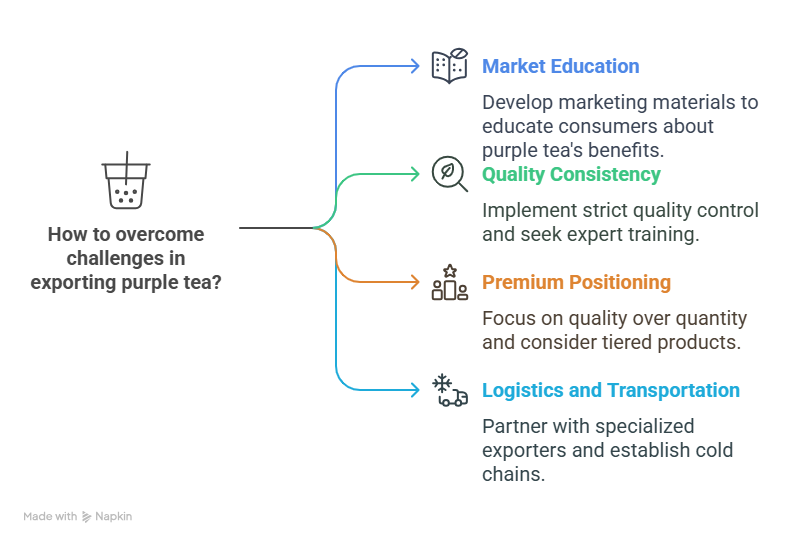
Success Story: Learning from Darius Kizito
Darius Kizito’s Umbui purple tea farm offers a blueprint for success in this sector. Over 14 years, he’s built a 4.4-hectare operation that:
- Employs dozens of local workers
- Supplies premium tea to processing factories
- Creates sustainable income year-round
- Earns significantly higher returns than traditional tea farming
His key insight? “I see a bright future for purple tea in this country. Farmers have realized it is more profitable compared to black tea.”
Your Purple Tea Export Roadmap
Ready to get started? Here’s your action plan:
- Research and planning (1-2 months)
- Visit existing purple tea farms and processors
- Develop detailed business and financial plans
- Identify target markets and potential buyers
- Land preparation and planting (3-6 months)
- Secure appropriate land
- Source quality seedlings from TRFK
- Prepare soil and plant your first crop
- Initial growth phase (12-18 months)
- Cultivate and tend young plants
- Develop processing relationships or capabilities
- Begin building market connections
- First harvest and market entry (18-24 months)
- Harvest initial crops
- Process according to market specifications
- Send samples to potential buyers
- Secure initial export orders
- Scaling and value addition (24+ months)
- Expand production area
- Develop branded products
- Implement value addition strategies
- Build direct relationships with end buyers
The timeline for reaching profitability varies, but with purple tea’s premium pricing, many farms see faster returns than with traditional tea varieties.
Conclusion: The Purple Opportunity
Kenya’s position as the world’s biggest exporter of black tea and third-largest tea producer gives you a solid foundation to build on. The country’s tea export performance has been strong, with volumes surging 20.8 percent in the first ten months of 2024 compared to the same period in 2023.
Purple tea represents the next evolution in this success story – a chance to capture premium prices in growing specialty markets while building on Kenya’s established reputation for quality tea.
The 25 years of research that went into developing Kenya’s purple tea varieties have created an opportunity for entrepreneurs who move quickly. As one early adopter put it, “we are on the brink of something new and exciting in the tea industry.”
Frequently Asked Questions
How much investment is needed to start a purple tea export business?
The initial investment varies based on your approach. For a small-scale operation (1-2 hectares), expect to invest approximately KES 1-2 million ($8,000-16,000) for land preparation, seedlings, basic equipment, and certification costs. If you’re adding processing capabilities, add another KES 3-5 million for equipment and facilities.
Many entrepreneurs start by focusing solely on cultivation and partnering with existing processors to minimize upfront costs. This approach lets you validate the market before making larger investments.
How long before my purple tea farm becomes profitable?
Purple tea plants take about 2-3 years to mature enough for the first commercial harvest. However, because of the premium pricing (up to 10x compared to black tea), the return on investment typically comes faster than with traditional tea varieties.
Most farmers see their operations break even within 4-5 years, compared to 6-8 years for conventional tea farming. Your timeline may be shorter if you implement value-addition strategies or develop direct market connections.
Do I need special permits to export purple tea from Kenya?
Yes, you’ll need:
- A tea dealer’s license from the Tea Board of Kenya
- An export permit for each shipment
- Phytosanitary certificates from the Kenya Plant Health Inspectorate Service (KEPHIS)
- Registration with the Kenya Export Promotion and Branding Agency
The good news is that these are generally straightforward to obtain if you meet the quality and safety requirements. Many exporters work with agencies that handle this paperwork as part of their services.
Is organic certification worth the investment for purple tea?
Absolutely. International buyers of specialty teas like purple tea typically pay significant premiums (20-40% above non-organic prices) for certified organic products. While certification requires additional investment and a 3-year transition period, the returns are substantial.
Many successful exporters use the transition period to establish their brand and develop market connections, then launch fully certified organic products once certification is complete.
Can I start a purple tea business if I don’t own land?
Yes, several options exist:
- Leasing land in tea-growing regions (common practice in Kenya)
- Contract farming arrangements with existing landowners
- Joining a cooperative that has land suitable for purple tea
- Starting at the processing or export stage by sourcing from existing farmers
Many successful tea entrepreneurs began without owning land and built their businesses through strategic partnerships before eventually acquiring their own farms.
How does climate change affect purple tea farming?
One of purple tea’s advantages is its resilience to changing climate conditions. The TRFK 306/1 variety was specifically developed to be:
- More drought-tolerant than conventional tea
- Resistant to common pests and diseases
- Able to withstand temperature fluctuations
This makes it particularly valuable as climate patterns become less predictable in traditional tea-growing regions. Many farmers are switching to purple tea partially as a climate adaptation strategy.
Ready to take the first step? Share your purple tea business plans or questions in the comments below, or contact me directly for personalized guidance on getting started with this high-potential export opportunity.




